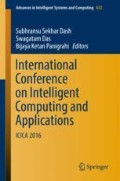Abstract
Compressive strength forms the major property which ensures safety and stability in the design of any concrete structure. Addition of admixtures makes concrete of higher strength, which is based on trial-and-error combinations. In the present study, an attempt is made for developing a tool for compressive strength prediction of reactive powder concrete by Mamdani-based fuzzy logic interface system (FIS). The eight main parameters which influencing the strength of concrete were considered as input variables. Database set of 100 data was collected from different literature reviews and worked with trial permutation and combination with different order of material inputs, and 125 rules are set. Twenty-five test results are examined to check the efficiency of the proposed tool and compared with the FIS output by applying various membership functions using both centroid and bisector methods of defuzzification. The predicted results show the potential efficiency of FIS in prediction of compressive strength for reactive powder concrete. The results obtained were satisfactory with high accuracy ranging from 95 to 99%.
Access this chapter
Tax calculation will be finalised at checkout
Purchases are for personal use only
References
P. Richard, Marcel Cheyrezy, “Composition of RPC”, cement and concrete research vol 2, no 7, pp 1501–1511, 0608-8846(95) 00144-1 (1995).
B.S Sahani, N.H.S Ray “A comparative study of RPC and OPC by ultra high strength technology”, IJR Vol 1, Issue-6, ISSN-2348-6848 (2014).
A. Zenati, K. Arroudj, M. Lanez, M.N Oudjit “Influence of cementatious additions on rheological and mechanical properties of RPC”, ELSEVIER, Science direct (2009).
Halit Yazici, Mert.Y Yardimici, Huseyin Yigiter, Serdar Aydin, Selcuk Turkel, “Mechanical properties of RPC containing high volume of GGBS” ELSEVIER, Cement and concrete composites 32, 639–648 (2010).
Halit Yazici, Huseyin Yigiter, Anil K, Bulent Bardan “Utilization of fly ash and GGBS as an alternative silica source in RPC”, ELSEVIER, Fuel 87, 2401–2407 (2008).
A. Cwirzen, V. Penttala, C. Varnanen “Reactive powder based concretes: Mechanical properties, durability and hybrid use with OPC”, ELSEVIER, Cement and concrete research 38, 1217–1226 (2008).
Mr Arjun Kumar, Dr Asha Udaya Rao, Dr Narayan Subhahit “Reactive powder concrete properties with cement replacement using waste material”, International Journal of Science and Engineering Research, Volume 4, Issue 5, ISSN2229-5518 (2013).
Z. Hang Yunsheng, Sun Wei, Liu Sifeng, Jiao Chujie, Lai Jianzhong “Preparation of C200green RPC and its static-dynamic behaviours” ELSEVIER, Cement and concrete composites 30, 831–838 (2008).
Yuh-Shiou Taai, Huang-Hsing Pan, Ying-Nienkung “Mechanical properties of steel fiber reinforced RPC exposed to high temperature reaching 800 degree centigrade”, ELSEVIER, Nuclear engineering and design 241, 2416–2424 (2011).
Alaa.A. Bashandy “Influence of elevated temperature on behavior of economical RPC”, Journal of civil engineering research, 3(3); 89–97, DOI:10.5923/J.JCE20130303.01 (2013).
O. Belalia Douma, B. Boukhalem, M. Ghrici “Prediction of strength of self compacting concrete containing fly ash using FIS”, (2014).
Gencelo, Ozelc, Koksal F, Martinez Barrera. G, Brostow. W, Polat. H “Fuzzy logic model for prediction of properties of fiber reinforced self compacting concrete”, Material science, Vol 19, no 2, pp-203–215, (2013).
Da Silva WRC, Stemberk P, “Predicting self compacting concrete shrinkage based on a modified fuzzy logic model”, Engineering mechanics, vol 229, pp-1173–1183, (2012).
C. Bas¸yigit, Iskender Akkurt, S. Kilincarslan, A. Beycioglu “ Prediction of strength of heavy weight concrete by ANN and FL models, Neural Comput & Applic, 19:507–513, DOI 10.1007/s00521-009-0292-9 (2010).
Hang-Guang N, Ji-Zang W, “Prediction of Compressive strength of concrete by ANN”, Cem Cancr Res; 30(8) 1245–50. (2000).
Gao F.L, “A new way of predicting cement strength fuzzy logic” Cement and concrete research, Vol 27, n 6 pp. 883–888, (1997).
Topcu I.B, Saridemir M “Prediction of rubberized concrete properties using ANN and FL”, Construction built mater 22:532–540 (2008).
Deka P.C, Diwate S.N “Modeling compressive strength of RMC using soft computing techniques”, International journal of earth sciences and engineering, Vol 4, no 6, pp 793–796, (2011).
Tanyildizi. H “Fuzzy logic model for prediction of mechanical properties of lightweight concrete exposed to high temperature”, Master Des 30:2205–2210, (2009).
Saridemir M et.al “Prediction of long term effects of GGBS on compressive strength of concrete by ANN and FL”, Construction Build mater 23:1279–1286.
E.H Mamdani “Fuzzy logic control of aggregate production planning”, S Assilian International Journal of man machine studies, vol7, pp 1–13. (1975).
Nehdi M.L, Bussuani M.T “Fuzzy logic approach for estimating durability of concrete”, Proceedings of ICE-Construction materials vol 62, n2, pp-81–92, (2009).
Muttukumaran P, Demirli K, Stiharu I, Bhat R.B “Boundary conditioning for structural tuning using fuzzy logic approach”, Compact struct, vol 74, n5, pp-547–557, (2000).
Sugeno.M, Kang G.T, “Structure identification of fuzzy model”, Fuzzy sets system cyber, vol 23, pp. 665–685, (1993).
LIU Shu-hua, LI Li-hua and FENG Jian-wen “Study on mechanical properties of RPC”, Journal of Civil engineering and construction 1:1 (2012).
Yuh-Shiou Tai, Huang-Hsing Pan, Ying-Nien Kung “Mechanical properties of steel fibers reinforced RPC following exposure of high temperature”, ELSEVIER, Nuclear engineering and Design 241, 2416–2424 (2011).
YS Tai “Uniaxial compression tests at various loadingrates for RPC”, ELSEVIER, Theoritical and Applied fracture mechanics 52, 14–21 (2009).
Jagannathasan Saravanan, Saranya Poovazhagen “Analytical study on compressive strength of RPC”, International journal of recent scientific research, Vol 6, Issue 5, pp-3872–3880, May (2015).
Author information
Authors and Affiliations
Corresponding author
Editor information
Editors and Affiliations
Rights and permissions
Copyright information
© 2018 Springer Nature Singapore Pte Ltd.
About this paper
Cite this paper
Nadiger, A., Harinath Reddy, C., Vasudevan, S., Mini, K.M. (2018). Fuzzy Logic Modeling for Strength Prediction of Reactive Powder Concrete. In: Dash, S., Das, S., Panigrahi, B. (eds) International Conference on Intelligent Computing and Applications. Advances in Intelligent Systems and Computing, vol 632. Springer, Singapore. https://doi.org/10.1007/978-981-10-5520-1_35
Download citation
DOI: https://doi.org/10.1007/978-981-10-5520-1_35
Published:
Publisher Name: Springer, Singapore
Print ISBN: 978-981-10-5519-5
Online ISBN: 978-981-10-5520-1
eBook Packages: EngineeringEngineering (R0)

